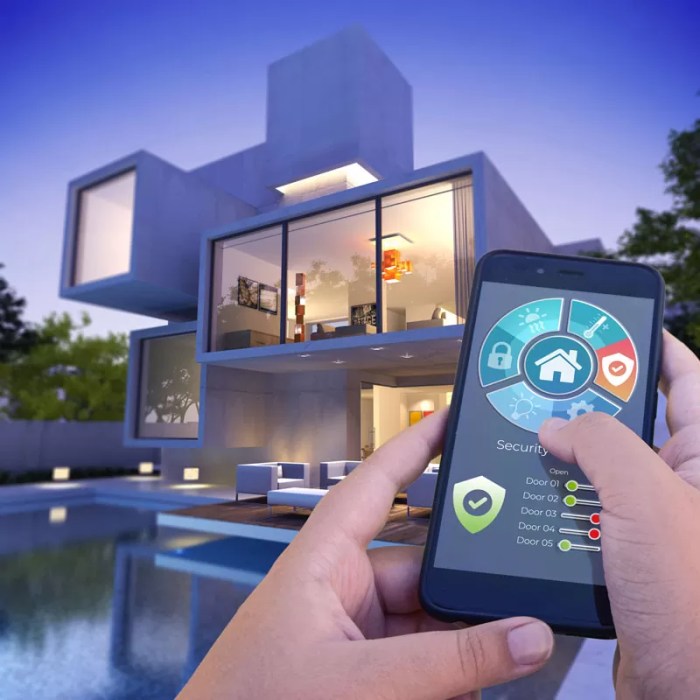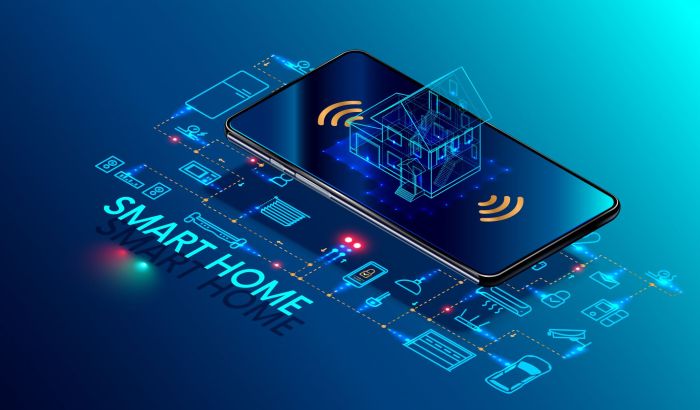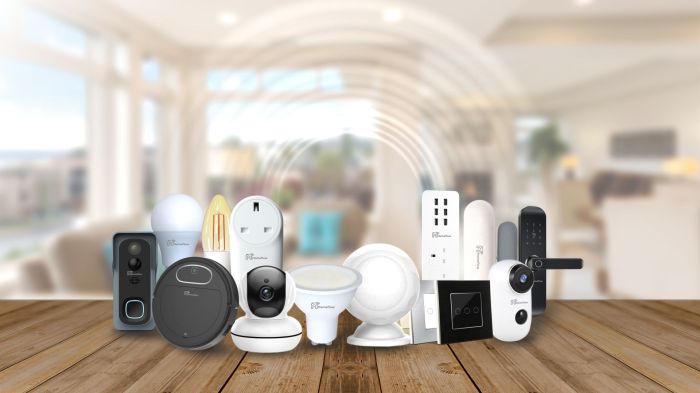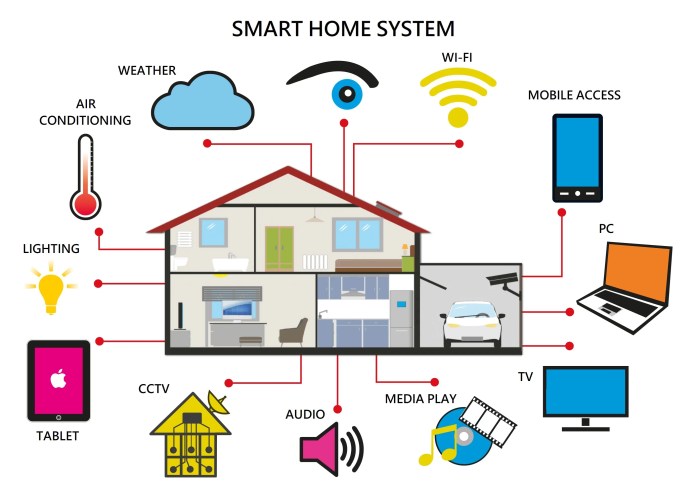In today’s fast-paced world, smart home systems have emerged as a game-changer, offering homeowners unprecedented control, convenience, and efficiency in managing their living spaces. From automating daily tasks to enhancing security and energy management, these systems are transforming the way we interact with our homes.
As the smart home market continues to flourish, a multitude of companies have stepped forward, each bringing unique innovations and solutions to the table. These companies are at the forefront of creating a connected and intelligent living environment, where technology seamlessly blends with our daily lives.
Smart Home Systems Market Overview

The global smart home systems market is experiencing substantial growth, driven by technological advancements, increasing demand for convenience, and rising concerns about energy efficiency and security. In 2023, the market was valued at approximately USD 100 billion and is projected to reach USD 250 billion by 2028, exhibiting a CAGR of 15%.
Market Segments
The smart home systems market can be segmented based on various factors, including product type, application, and distribution channel. Product Type:
- Smart Lighting
- Smart Thermostats
- Smart Security Systems
- Smart Entertainment Systems
- Smart Appliances
Application:
- Residential
- Commercial
- Industrial
Distribution Channel:
- DIY (Do-It-Yourself)
- Professionally Installed Systems
The DIY segment holds a significant market share due to its affordability, ease of installation, and growing awareness among consumers. However, professionally installed systems are gaining traction due to their reliability, customization options, and enhanced security features.
Key Market Drivers
Rising Demand for Convenience: Smart home systems offer convenience and automation, enabling users to control various devices and appliances remotely using smartphones, tablets, or voice assistants. Growing Awareness of Energy Efficiency: Smart thermostats and lighting systems help optimize energy consumption, reducing utility bills and promoting sustainability.
Increasing Security Concerns: Smart security systems provide real-time monitoring, alerts, and remote access to security cameras, enhancing home security.
Challenges
High Initial Cost: The upfront cost of smart home systems can be a deterrent for some consumers, especially for professionally installed systems. Cybersecurity Concerns: Smart home systems involve connectivity to the internet, raising concerns about cybersecurity and data privacy.
Lack of Interoperability: The lack of interoperability between different smart home devices and platforms can limit functionality and create compatibility issues.
Leading Smart Home Systems Companies

The smart home systems industry is dominated by a handful of key players that have established a strong market presence through innovative product offerings, strategic partnerships, and effective marketing campaigns.
These leading companies are driving the growth of the industry and shaping the future of smart home technology. They are constantly pushing the boundaries of innovation and introducing new products and services that enhance the convenience, security, and energy efficiency of homes.
Company Profiles
- Google Nest: Google Nest is a leading provider of smart home products and services. The company offers a wide range of products, including smart thermostats, security cameras, smoke detectors, and doorbells. Nest products are known for their sleek design, ease of use, and integration with other Google products.
- Amazon Alexa: Amazon Alexa is a voice-activated virtual assistant that can control a wide range of smart home devices. Alexa-enabled devices include smart speakers, thermostats, lights, and doorbells. Alexa is known for its natural language processing capabilities and its ability to learn and adapt to user preferences.
- Apple HomeKit: Apple HomeKit is a smart home platform that allows users to control their smart home devices from their Apple devices. HomeKit-enabled devices include thermostats, lights, door locks, and security cameras. HomeKit is known for its ease of use and its seamless integration with Apple’s ecosystem of products and services.
- Samsung SmartThings: Samsung SmartThings is a smart home platform that allows users to control their smart home devices from their Samsung devices. SmartThings-enabled devices include thermostats, lights, door locks, and security cameras. SmartThings is known for its wide range of compatible devices and its powerful automation features.
- ADT: ADT is a leading provider of home security systems. The company offers a wide range of smart home products and services, including security cameras, motion sensors, and door locks. ADT is known for its reliable security systems and its professional installation and monitoring services.
Market Shares
The leading smart home systems companies have a significant share of the global market. According to a report by Strategy Analytics, Google Nest, Amazon Alexa, Apple HomeKit, Samsung SmartThings, and ADT collectively accounted for over 70% of the global smart home systems market in 2021.
Google Nest and Amazon Alexa are the two largest players in the market, with market shares of 28% and 24%, respectively. Apple HomeKit and Samsung SmartThings are also major players, with market shares of 15% and 12%, respectively. ADT is a leading provider of home security systems, with a market share of 11%.
Competitive Strategies
The leading smart home systems companies are competing fiercely for market share. They are constantly introducing new products and services, forming strategic partnerships, and investing in research and development.
Google Nest and Amazon Alexa are focused on expanding their ecosystems of smart home devices and services. They are also investing heavily in artificial intelligence and machine learning to improve the performance of their voice assistants.
Apple HomeKit and Samsung SmartThings are focused on providing a seamless experience for users of their respective mobile devices. They are also working to expand their ecosystems of compatible devices.
ADT is focused on providing reliable and comprehensive home security systems. The company is also investing in new technologies, such as artificial intelligence and machine learning, to improve the performance of its systems.
Key Technologies and Innovations
Smart home systems are undergoing a wave of innovation, driven by advancements in IoT connectivity, artificial intelligence (AI), and voice control. These technologies are transforming the way people interact with their homes, making them more efficient, secure, and convenient.
IoT connectivity enables devices to communicate with each other and with the internet, creating a seamless network of smart devices. This allows homeowners to control their home’s lighting, heating, cooling, and security systems from anywhere, using a smartphone or tablet.
AI algorithms analyze data collected from these devices to learn user preferences and patterns, enabling the system to automate tasks and make recommendations.
IoT Connectivity
IoT connectivity is the foundation of smart home systems, allowing devices to communicate with each other and with the internet. This enables remote control and monitoring of home appliances, lighting, and security systems, as well as the ability to create automated routines and receive notifications.
- Benefits:
- Remote control and monitoring of home devices
- Automated routines and notifications
- Increased convenience and security
Artificial Intelligence
Artificial intelligence (AI) is transforming smart home systems by enabling them to learn user preferences and patterns, automate tasks, and make recommendations. AI algorithms analyze data collected from sensors and devices to understand how homeowners use their homes, and they can then adjust the system’s settings accordingly.
- Benefits:
- Automated tasks and routines
- Personalized recommendations
- Improved energy efficiency and security
Voice Control
Voice control is a convenient and intuitive way to interact with smart home systems. Homeowners can use their voice to control lights, thermostats, music, and other devices, making it easy to manage their home without having to lift a finger.
- Benefits:
- Convenient and intuitive control
- Hands-free operation
- Increased accessibility for people with disabilities
Innovative Smart Home Products
The combination of IoT connectivity, AI, and voice control has led to the development of innovative smart home products that are changing the way people live.
- Smart thermostats:
- Learn user preferences and adjust the temperature accordingly
- Save energy and money
- Smart lights:
- Can be controlled remotely and programmed to turn on and off at specific times
- Create different lighting scenes for different occasions
- Smart speakers:
- Allow homeowners to control their smart home devices with their voice
- Play music, answer questions, and provide information
Smart Home System Features and Functionality

Smart home systems are equipped with a range of features and functionalities that enhance comfort, convenience, and energy efficiency. These systems typically include security, automation, energy management, and entertainment capabilities.
Security Features
Smart home systems provide comprehensive security measures to protect homes and families. These features include:
- Motion sensors: Detect movement inside or outside the home, triggering alerts and activating security measures.
- Door and window sensors: Monitor openings for unauthorized access, sending alerts when doors or windows are opened unexpectedly.
- Security cameras: Offer real-time monitoring and recording of activity inside and outside the home, allowing remote viewing through smartphones or tablets.
- Smart locks: Enable keyless entry and remote locking/unlocking of doors, providing enhanced security and convenience.
Automation Features
Smart home systems automate various tasks and processes, simplifying daily routines and enhancing convenience. These features include:
- Lighting control: Allow users to control lights throughout the home using voice commands, smartphones, or preset schedules, creating personalized lighting scenes and saving energy.
- Thermostat control: Enable remote adjustment of thermostats, allowing users to manage heating and cooling systems efficiently, reducing energy consumption and increasing comfort.
- Appliance control: Integrate with smart appliances, enabling users to remotely control and monitor devices such as ovens, refrigerators, and washing machines.
- Voice control: Provide hands-free control of smart home devices using voice commands, enhancing convenience and accessibility.
Energy Management Features
Smart home systems offer energy management capabilities that help reduce energy consumption and save money. These features include:
- Energy monitoring: Track energy usage in real-time, providing detailed insights into energy consumption patterns and identifying areas for improvement.
- Smart thermostats: Optimize heating and cooling systems based on occupancy and preferences, reducing energy waste and maintaining comfortable temperatures.
- Smart lighting: Automatically adjust lighting levels based on natural light and occupancy, conserving energy and creating a more comfortable ambiance.
- Smart appliances: Energy-efficient appliances with smart features, such as dishwashers that adjust water usage based on the load size, contribute to energy savings.
Entertainment Features
Smart home systems integrate entertainment systems, allowing users to control and enjoy their favorite media seamlessly. These features include:
- Smart TVs: Offer access to streaming services, apps, and personalized recommendations, providing a wide range of entertainment options.
- Smart speakers: Play music, control smart home devices, and provide information and news updates using voice commands.
- Home theater systems: Integrate audio and video components to create a cinematic experience in the comfort of the home.
- Multi-room audio: Allow users to stream music throughout the home, creating a synchronized and immersive audio experience.
Benefits and Challenges of Smart Home Systems
Smart home systems offer a range of benefits to homeowners, including convenience, security, and energy savings. These systems allow homeowners to control various aspects of their homes, such as lighting, heating, and cooling, remotely using a smartphone or tablet. This convenience can be especially useful for busy individuals or those with mobility issues.
Additionally, smart home systems can enhance security by providing real-time alerts for potential threats, such as break-ins or fires. They can also help homeowners save energy by automatically adjusting lighting and temperature settings based on occupancy and usage patterns.
Challenges of Smart Home Systems
Despite the numerous benefits, smart home systems also pose certain challenges. One potential concern is privacy. These systems collect and transmit data about homeowners’ activities and preferences, which raises concerns about potential misuse or unauthorized access. Additionally, compatibility issues can arise when integrating different smart home devices from various manufacturers.
This can lead to difficulties in setting up and operating the system. Lastly, the initial installation costs of smart home systems can be substantial, which may deter some homeowners from adopting these technologies.
Addressing the Challenges
To address privacy concerns, homeowners should carefully review the privacy policies of smart home system providers and choose reputable companies with strong security measures in place. Additionally, they can take steps to secure their home networks and use strong passwords.
To overcome compatibility issues, homeowners can opt for systems that are built on open standards and platforms. This allows for easier integration of devices from different manufacturers. Finally, the upfront costs of smart home systems can be offset by the long-term savings on energy bills and the increased convenience and security they provide.
Smart Home System Design and Installation
Designing and installing a smart home system involves careful planning, system integration, and a focus on security. The goal is to create a cohesive, functional, and secure smart home environment.
Prior to the installation, a comprehensive plan that Artikels the system’s objectives, device compatibility, and integration requirements should be established. This plan should take into account the specific needs and preferences of the homeowner, ensuring a personalized and tailored solution.
Guidelines for Designing and Installing Smart Home Systems
To ensure a successful smart home system design and installation, several guidelines should be followed:
- Start with a clear plan: Develop a detailed plan that Artikels the desired outcomes, device compatibility, and integration requirements. This plan should serve as a roadmap for the entire process.
- Consider system integration: Ensure that the chosen smart home system is compatible with existing devices and infrastructure. This includes checking for compatibility with devices such as lighting, thermostats, and security systems.
- Prioritize security: Implement robust security measures to protect the smart home system from unauthorized access and cyber threats. This includes using strong passwords, enabling two-factor authentication, and keeping software up to date.
- Focus on user-friendliness: Design the system to be intuitive and easy to use for all household members. This includes providing clear instructions, user-friendly interfaces, and voice control options.
- Plan for future expansion: Consider the potential for future expansion and upgrades when designing the system. This includes leaving room for additional devices and ensuring that the system can accommodate future software updates.
Smart Home System Maintenance and Troubleshooting

Regular maintenance of smart home systems is crucial to ensure optimal performance, prevent malfunctions, and extend the lifespan of the devices. By addressing potential issues promptly, homeowners can avoid costly repairs and disruptions to their smart home experience.
Maintenance involves checking for system updates, performing routine diagnostics, and inspecting hardware components. Troubleshooting common issues, such as connectivity problems, device compatibility, or software glitches, can be done by following troubleshooting guides or seeking assistance from the system manufacturer or a qualified technician.
Tips for Troubleshooting Common Issues
- Check the internet connection and ensure that all devices are properly connected to the network.
- Restart the smart home system, including the hub, router, and individual devices, to resolve minor glitches.
- Update the firmware and software of the system and devices to address bugs and improve performance.
- Ensure compatibility between devices and the smart home system by checking the manufacturer’s specifications.
- Inspect sensors and detectors for proper placement, cleanliness, and functionality.
Importance of Software Updates and Security Patches
Software updates and security patches play a vital role in maintaining the performance and security of smart home systems. These updates often include bug fixes, performance enhancements, and security patches to protect against vulnerabilities and cyber threats. Regular updates ensure that the system operates at its best, reduces the risk of security breaches, and improves overall user experience.
Smart Home System Security and Privacy

Smart home systems offer convenience and automation, but they also introduce new security and privacy concerns. Unsecured smart devices can provide entry points for unauthorized access, leading to data breaches, privacy violations, and even physical harm. To ensure a secure and private smart home environment, it’s crucial to implement robust security measures and be aware of potential risks.
Security Risks Associated with Smart Home Systems
Smart home systems face several security risks, including:
- Unauthorized Access: Unsecured smart devices can be accessed remotely by unauthorized individuals, allowing them to control devices, steal personal information, or spy on occupants.
- Malware and Viruses: Smart devices can be infected with malware or viruses, which can compromise their functionality and security, leading to data breaches or system malfunctions.
- Data Breaches: Smart home systems collect and transmit large amounts of personal data, which can be intercepted or hacked, leading to identity theft or other privacy violations.
- Physical Security Breaches: Smart home systems, such as smart locks and cameras, can be bypassed or disabled, allowing unauthorized individuals to gain physical access to the home.
Recommendations for Securing Smart Home Networks and Devices
To mitigate security risks, it’s essential to implement robust security measures for smart home networks and devices:
- Use Strong Passwords: Use unique and complex passwords for all smart home devices and accounts. Avoid using default passwords or easily guessable combinations.
- Enable Two-Factor Authentication: Whenever available, enable two-factor authentication for smart home accounts and devices. This adds an extra layer of security by requiring a second form of identification, such as a code sent to a mobile phone.
- Keep Devices and Software Updated: Regularly update smart home devices and software to ensure they have the latest security patches and fixes. Outdated devices and software are more vulnerable to security breaches.
- Use a Secure Home Network: Use a strong and encrypted home Wi-Fi network with a firewall to protect smart home devices from unauthorized access.
- Segment Smart Home Devices: Create a separate network or subnet for smart home devices, isolating them from other devices on the home network.
- Use VPN: Consider using a virtual private network (VPN) to encrypt internet traffic and protect smart home devices from external threats.
- Physical Security Measures: Implement physical security measures, such as strong locks and security cameras, to deter unauthorized physical access to smart home devices.
Data Privacy and Responsible Use of Personal Information
Smart home systems collect and transmit large amounts of personal data, raising concerns about data privacy and the responsible use of this information. It’s essential for smart home companies to implement transparent data privacy policies and practices, including:
- Transparency: Clearly communicate the type of data collected, the purpose of collection, and how the data will be used.
- Consent: Obtain explicit consent from users before collecting and using their personal data.
- Data Security: Implement robust security measures to protect personal data from unauthorized access, use, or disclosure.
- Data Retention: Clearly define the period for which personal data will be retained and provide users with the ability to request deletion of their data.
- Data Sharing: Be transparent about data sharing practices with third parties and obtain consent from users before sharing their data.
Smart Home System Trends and Future Outlook
With advancements in technology, the smart home systems market is undergoing a transformation. Emerging trends and technologies are shaping the future of smart homes, offering new possibilities and enhancing user experiences.
5G Connectivity and Smart Home Systems
The advent of 5G connectivity promises to revolutionize smart home systems. With its ultra-fast speeds, low latency, and increased bandwidth, 5G will enable seamless communication and data transfer among smart devices. This will facilitate real-time monitoring, control, and automation of various home appliances and systems, leading to improved efficiency, convenience, and responsiveness.
Artificial Intelligence and Smart Home Systems
Artificial intelligence (AI) is playing a pivotal role in advancing smart home systems. AI-powered devices and platforms can learn user preferences, anticipate needs, and make intelligent decisions to optimize home environments. AI algorithms analyze data from various sensors and devices to provide personalized recommendations, automate tasks, and enhance overall user experience.
Internet of Things (IoT) and Smart Home Systems
The Internet of Things (IoT) is fundamentally changing the way smart home systems operate. By connecting various devices and appliances to the internet, IoT enables seamless communication and data exchange among them. This interconnectedness allows for centralized control, remote monitoring, and automated responses to various events or triggers.
IoT devices collect and transmit data to a central hub, which processes the information and initiates appropriate actions.
Future of Smart Home Systems
The future of smart home systems holds immense potential for innovation and transformation. With the convergence of 5G, AI, and IoT, smart homes will become increasingly intelligent, responsive, and personalized. Here are some potential applications:
- Predictive Maintenance: AI algorithms will analyze data from various sensors to predict potential issues with appliances or systems before they occur, enabling proactive maintenance and preventing breakdowns.
- Energy Optimization: Smart home systems will leverage AI and IoT to optimize energy consumption by learning user patterns and preferences. They will automatically adjust lighting, heating, and cooling systems to reduce energy waste and promote sustainability.
- Enhanced Security: Smart home systems will incorporate advanced security features, such as facial recognition, motion detection, and AI-powered surveillance, to protect homes from intruders and potential threats.
- Personalized Experiences: AI-powered smart home systems will tailor experiences to individual users’ preferences. They will learn and adapt to user routines, habits, and needs, providing personalized recommendations, entertainment suggestions, and customized home automation.
The integration of emerging technologies will continue to drive innovation in the smart home systems market, offering new possibilities and enhancing user experiences. As these technologies evolve, smart homes will become more intelligent, responsive, and seamlessly integrated into our daily lives.
Conclusion
The future of smart home systems is brimming with possibilities. As technology continues to advance, we can expect even more seamless integration, enhanced security features, and personalized experiences. Smart home systems are not just the future; they are already transforming the way we live, making our homes smarter, more efficient, and more enjoyable.
Helpful Answers
What are the key factors driving the growth of smart home systems companies?
The rising demand for convenience, increased security concerns, growing awareness of energy efficiency, and advancements in IoT technology are key factors fueling the growth of smart home systems companies.
What are some common challenges faced by smart home systems companies?
Ensuring compatibility and interoperability among different devices, addressing privacy and security concerns, and providing reliable customer support are some of the challenges faced by smart home systems companies.
How can homeowners choose the right smart home system for their needs?
Consider factors such as the desired level of automation, compatibility with existing devices, ease of installation and use, and the reputation and customer support offered by the smart home system company.